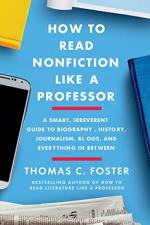
|
| Name: _________________________ | Period: ___________________ |
This test consists of 5 multiple choice questions, 5 short answer questions, and 10 short essay questions.
Multiple Choice Questions
1. In Chapter 9, "Living the News," what does Foster say is the main difference between New Journalism and immersive journalism?
(a) Immersive journalists use many more techniques usually found in fiction.
(b) Immersive journalists do not try to draw attention to themselves.
(c) Immersive journalists want to be seen as clever, inventive writers.
(d) Immersive journalists are strictly objective.
2. In Chapter 14, "The Universe of Ideas/Ideas of the Universe," what does Foster call critical reading?
(a) Defensive reading.
(b) Scientific reading.
(c) Nonfiction analysis.
(d) Nonfiction evaluation.
3. In Chapter 13, "On the Stump," Foster says that a look at social media reveals what about Americans of all political persuasions?
(a) They are eager for a leader who will heal political divisions.
(b) They have lost touch with reality.
(c) Many on both sides are strong critical thinkers.
(d) Many on both sides are blind to what makes America great.
4. What is being discussed in Chapter 10, "From the Inside Out," when Foster says that the "form and tone of the essay must fit the writer like a suit" (144)?
(a) Subjectivity and attachment.
(b) Characterization and personality.
(c) Style and voice.
(d) Conflict and theme.
5. In Chapter 9, "Living the News," how does Foster apply the idea of "free indirect speech" to New Journalism?
(a) He uses it to label Wolfe's attempt to recreate the inner lives of his subjects.
(b) He uses it to explain how Thompson narrates his own thoughts.
(c) He uses it to compare New Journalism with immersive journalism.
(d) He uses it to contrast New Journalism with fiction.
Short Answer Questions
1. In Chapter 10, "From the Inside Out," what type of nonfiction writing does Foster refer to as "soggy" (141), and "soul-deadening" (142)?
2. In "Interrogating the Text," Foster says that he himself tends to "eschew" notes. He is saying what about his use of notes?
3. In Chapter 13, "On the Stump," Foster says that the chief aim of Fire and Fury is to demonstrate what?
4. According to Foster in Chapter 9, "Living the News," what is McPhee's purpose in comparing geological change over time to a road trip?
5. In Chapter 13, "On the Stump," which work does Foster say that Comey's book A Higher Loyalty is similar to?
Short Essay Questions
1. In Chapter 13, "On the Stump," what criticism does Foster level at Fox News?
2. In Chapter 9, "Living the News," why does Foster say that Hunter S. Thomson's Fear and Loathing in Las Vegas is really a roman à clef?
3. In Chapter 10, "From the Inside Out," what does Foster list as the three criteria of Ezra Pound's criticism?
4. In Chapter 10, "From the Inside Out," what characteristics does Foster say the thesis of a strong essay will have?
5. In "Interrogating the Text," what does Foster say the purpose of interrogating text is?
6. In Chapter 9, "Living the News," what two main types of subjective nonfiction does Foster define, and what four categories does he break these main types into?
7. In Chapter 9, "Living the News," what does Foster admire about the writing of John McPhee?
8. In Chapter 13, "On the Stump," what are the three categories that Foster says outsider exposés fall into, and why does he say that they are more reliable than insider's writings?
9. In Chapter 11, "Life from the Inside," why does Foster spend time describing the contents of Cardinal Newman's autobiography?
10. In Chapter 14, "The Universe of Ideas/Ideas of the Universe," what are the three types of science writing that Foster describes, and what are the differences among them?
|
This section contains 1,044 words (approx. 4 pages at 300 words per page) |

|




